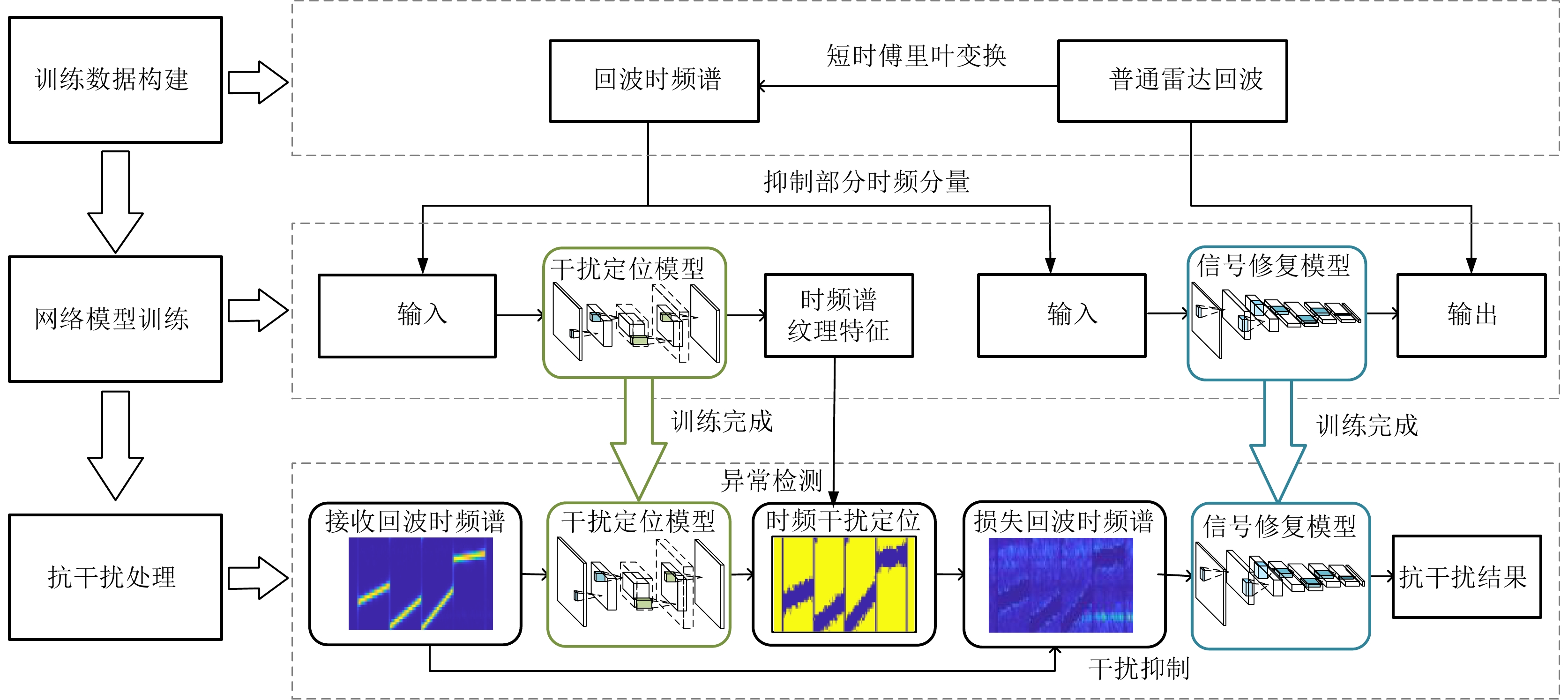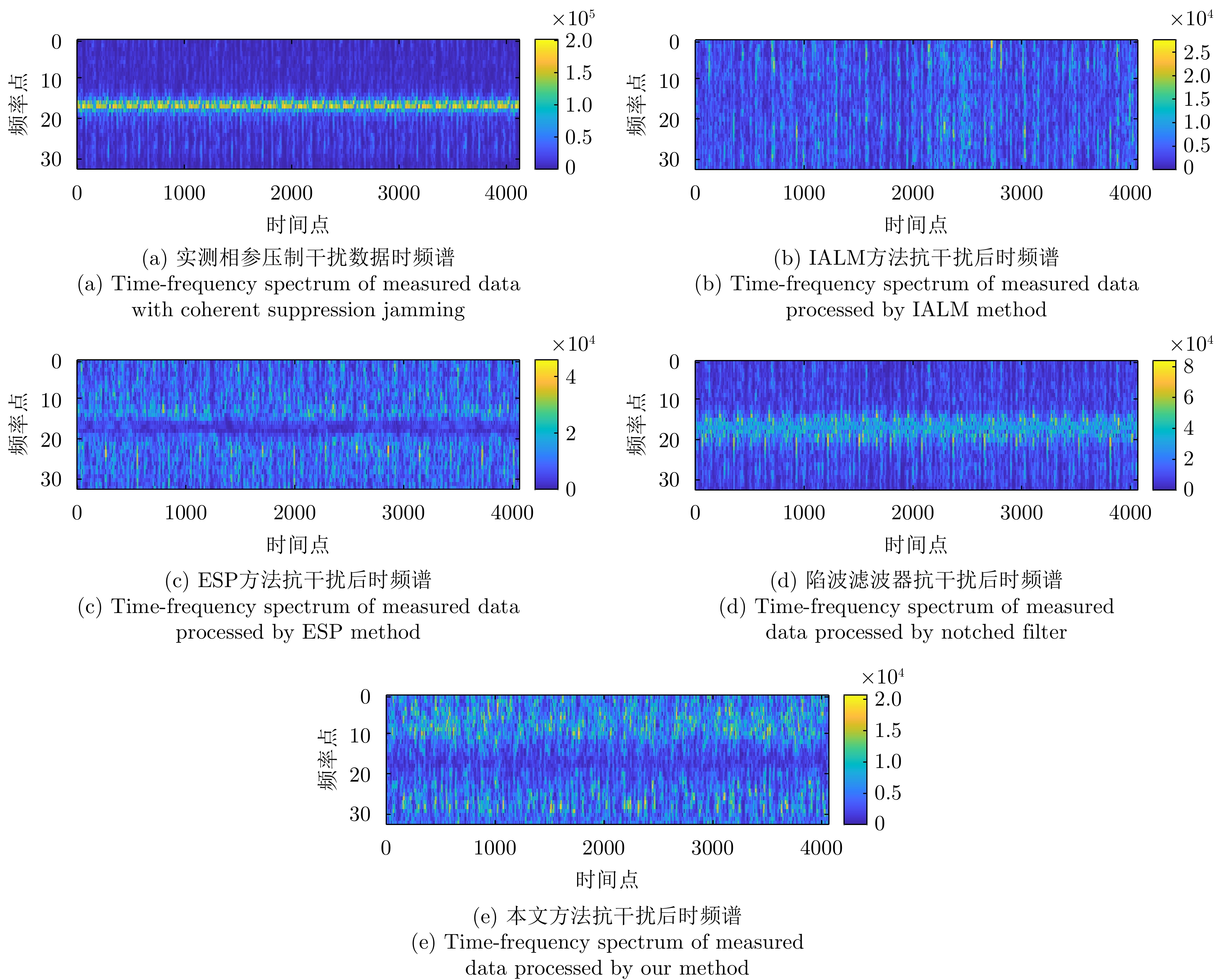| [1] |
LENG Xiangguang, JI Kefeng, ZHOU Shilin, et al. Fast shape parameter estimation of the complex generalized Gaussian distribution in SAR images[J]. IEEE Geoscience and Remote Sensing Letters, 2020, 17(11): 1933–1937. doi: 10.1109/LGRS.2019.2960095 |
| [2] |
HUANG Yan, ZHANG Lei, LI Jie, et al. Reweighted tensor factorization method for SAR narrowband and wideband interference mitigation using smoothing multiview tensor model[J]. IEEE Transactions on Geoscience and Remote Sensing, 2020, 58(5): 3298–3313. doi: 10.1109/TGRS.2019.2953069 |
| [3] |
李永祯, 黄大通, 邢世其, 等. 合成孔径雷达干扰技术研究综述[J]. 雷达学报, 2020, 9(5): 753–764. doi: 10.12000/JR20087LI Yongzhen, HUANG Datong, XING Shiqi, et al. A review of synthetic aperture radar jamming technique[J]. Journal of Radars, 2020, 9(5): 753–764. doi: 10.12000/JR20087 |
| [4] |
黄岩, 赵博, 陶明亮, 等. 合成孔径雷达抗干扰技术综述[J]. 雷达学报, 2020, 9(1): 86–106. doi: 10.12000/JR19113HUANG Yan, ZHAO Bo, TAO Mingliang, et al. Review of synthetic aperture radar interference suppression[J]. Journal of Radars, 2020, 9(1): 86–106. doi: 10.12000/JR19113 |
| [5] |
MEYER F J, NICOLL J B, and DOULGERIS A P. Correction and characterization of radio frequency interference signatures in L-band synthetic aperture radar data[J]. IEEE Transactions on Geoscience and Remote Sensing, 2013, 51(10): 4961–4972. doi: 10.1109/TGRS.2013.2252469 |
| [6] |
DAKOVIĆ M, THAYAPARAN T, DJUKANOVIĆ S, et al. Time-frequency-based non-stationary interference suppression for noise radar systems[J]. IET Radar, Sonar & Navigation, 2008, 2(4): 306–314. doi: 10.1049/iet-rsn:20070137 |
| [7] |
ZHOU Feng, TAO Mingliang, BAI Xueru, et al. Narrow-band interference suppression for SAR based on independent component analysis[J]. IEEE Transactions on Geoscience and Remote Sensing, 2013, 51(10): 4952–4960. doi: 10.1109/TGRS.2013.2244605 |
| [8] |
TAO Mingliang, ZHOU Feng, LIU Jianqiang, et al. Narrow-band interference mitigation for SAR using independent subspace analysis[J]. IEEE Transactions on Geoscience and Remote Sensing, 2014, 52(9): 5289–5301. doi: 10.1109/TGRS.2013.2287900 |
| [9] |
TAO Mingliang, ZHOU Feng, and ZHANG Zijing. Wideband interference mitigation in high-resolution airborne synthetic aperture radar data[J]. IEEE Transactions on Geoscience and Remote Sensing, 2016, 54(1): 74–87. doi: 10.1109/TGRS.2015.2450754 |
| [10] |
DJUKANOVIC S and POPOVIC V. A parametric method for multicomponent interference suppression in noise radars[J]. IEEE Transactions on Aerospace and Electronic Systems, 2012, 48(3): 2730–2738. doi: 10.1109/TAES.2012.6237624 |
| [11] |
LIU Zhiling, LIAO Guisheng, and YANG Zhiwei. Time variant RFI suppression for SAR using iterative adaptive approach[J]. IEEE Geoscience and Remote Sensing Letters, 2013, 10(6): 1424–1428. doi: 10.1109/LGRS.2013.2259575 |
| [12] |
YANG Zhiwei, DU Wentao, LIU Zhiling, et al. WBI suppression for SAR using iterative adaptive method[J]. IEEE Journal of Selected Topics in Applied Earth Observations and Remote Sensing, 2016, 9(3): 1008–1014. doi: 10.1109/JSTARS.2015.2470107 |
| [13] |
JOY S, NGUYEN L H, and TRAN T D. Radio frequency interference suppression in ultra-wideband synthetic aperture radar using range-azimuth sparse and low-rank model[C]. 2016 IEEE Radar Conference, Philadelphia, USA, 2016: 1–4.
|
| [14] |
NGUYEN L H and TRAN T D. Efficient and robust RFI extraction via sparse recovery[J]. IEEE Journal of Selected Topics in Applied Earth Observations and Remote Sensing, 2016, 9(6): 2104–2117. doi: 10.1109/JSTARS.2016.2528884 |
| [15] |
LIU Hongqing, LI Dong, ZHOU Yi, et al. Joint wideband interference suppression and SAR signal recovery based on sparse representations[J]. IEEE Geoscience and Remote Sensing Letters, 2017, 14(9): 1542–1546. doi: 10.1109/LGRS.2017.2721425 |
| [16] |
WANG Yafeng, SUN Boye, and WANG Ning. Recognition of radar active-jamming through convolutional neural networks[J]. The Journal of Engineering, 2019, 2019(21): 7695–7697. doi: 10.1049/joe.2019.0659 |
| [17] |
ZHAO Qingyuan, LIU Yang, CAI Linjie, et al. Research on electronic jamming identification based on CNN[C]. 2019 IEEE International Conference on Signal, Information and Data Processing (ICSIDP), Chongqing, China, 2019: 1–5.
|
| [18] |
LIN Junjie and FAN Xiaolei. Radar active jamming recognition based on recurrence plot and convolutional neural network[C]. 2021 IEEE 4th Advanced Information Management, Communicates, Electronic and Automation Control Conference (IMCEC), Chongqing, China, 2021: 1511–1515.
|
| [19] |
QIU Lei and FAN Yize. A radar jamming recognition method based on hybrid dilated convolution[C]. 2022 3rd International Conference on Computer Vision, Image and Deep Learning & International Conference on Computer Engineering and Applications (CVIDL & ICCEA), Changchun, China, 2022: 692–695.
|
| [20] |
FAN Weiwei, ZHOU Feng, RONG Pengshuai, et al. Interference mitigation for synthetic aperture radar using deep learning[C]. 2019 6th Asia-Pacific Conference on Synthetic Aperture Radar (APSAR), Xiamen, China, 2019: 1–6.
|
| [21] |
CHEN Shengyi, SHANGGUAN Wangyi, TAGHIA J, et al. Automotive radar interference mitigation based on a generative adversarial network[C]. 2020 IEEE Asia-Pacific Microwave Conference (APMC), Hong Kong, China, 2020: 728–730.
|
| [22] |
NAIR A A, RANGAMANI A, NGUYEN L H, et al. Spectral gap extrapolation and radio frequency interference suppression using 1D UNets[C]. 2021 IEEE Radar Conference, Atlanta, USA, 2021: 1–6.
|
| [23] |
MUN J, HA S, and LEE J. Automotive radar signal interference mitigation using RNN with self attention[C]. IEEE International Conference on Acoustics, Speech and Signal Processing, Barcelona, Spain, 2020: 3802–3806.
|
| [24] |
HASELMANN M, GRUBER D P, and TABATABAI P. Anomaly detection using deep learning based image completion[C]. 17th IEEE International Conference on Machine Learning and Applications (ICMLA), Orlando, USA, 2018: 1237–1242.
|
| [25] |
IOFFE S and SZEGEDY C. Batch normalization: Accelerating deep network training by reducing internal covariate shift[C]. 32nd International Conference on Machine Learning, Lille, France, 2015: 448–456.
|
| [26] |
KRIZHEVSKY A, SUTSKEVER I, and HINTON G E. ImageNet classification with deep convolutional neural networks[J]. Communications of the ACM, 2017, 60(6): 84–90. doi: 10.1145/3065386 |
| [27] |
HE Kaiming, ZHANG Xiangyu, REN Shaoqing, et al. Deep residual learning for image recognition[C]. 2016 IEEE Conference on Computer Vision and Pattern Recognition (CVPR), Las Vegas, USA, 2016: 770–778.
|
| [28] |
SIMONYAN K and ZISSERMAN A. Very deep convolutional networks for large-scale image recognition[C]. 3rd International Conference on Learning Representations, San Diego, USA, 2015: 1–14.
|
| [29] |
WANG Zhou, BOVIK A C, SHEIKH H R, et al. Image quality assessment: From error visibility to structural similarity[J]. IEEE Transactions on Image Processing, 2004, 13(4): 600–612. doi: 10.1109/tip.2003.819861 |
| [30] |
PASZKE A, GROSS S, MASSA F, et al. PyTorch: An imperative style, high-performance deep learning library[C]. 33rd International Conference on Neural Information Processing System, Vancouver, Canada, 2019: 8026–8037.
|
| [31] |
KINGMA D P and BA J. Adam: A method for stochastic optimization[C]. 3rd International Conference on Learning Representations (ICLR), San Diego, USA, 2015.
|
| [32] |
MOWLAEE P, SAEIDI R, CHRISTENSEN M G, et al. Subjective and objective quality assessment of single-channel speech separation algorithms[C]. 2012 IEEE International Conference on Acoustics, Speech and Signal Processing (ICASSP), Kyoto, Japan, 2012: 69–72.
|
| [33] |
刘忠. 基于DRFM的线性调频脉冲压缩雷达干扰新技术[D]. [博士论文], 国防科学技术大学, 2006.
LIU Zhong. Jamming technique for countering LFM pulse compression radar based on digital radio frequency memory[D]. [Ph. D. dissertation], National University of Defense Technology, 2006.
|
| [34] |
SANDLER M, HOWARD A, ZHU Menglong, et al. MobileNetV2: Inverted residuals and linear bottlenecks[C]. 2018 IEEE/CVF Conference on Computer Vision and Pattern Recognition, Salt Lake City, USA, 2018: 4510–4520.
|
| [35] |
MA Ningning, ZHANG Xiangyu, ZHENG Haitao, et al. ShuffleNet V2: Practical guidelines for efficient CNN architecture design[C]. 15th European Conference on Computer Vision (ECCV), Munich, Germany, 2018: 122–138.
|




 Submit Manuscript
Submit Manuscript Peer Review
Peer Review Editor Work
Editor Work





 DownLoad:
DownLoad:













